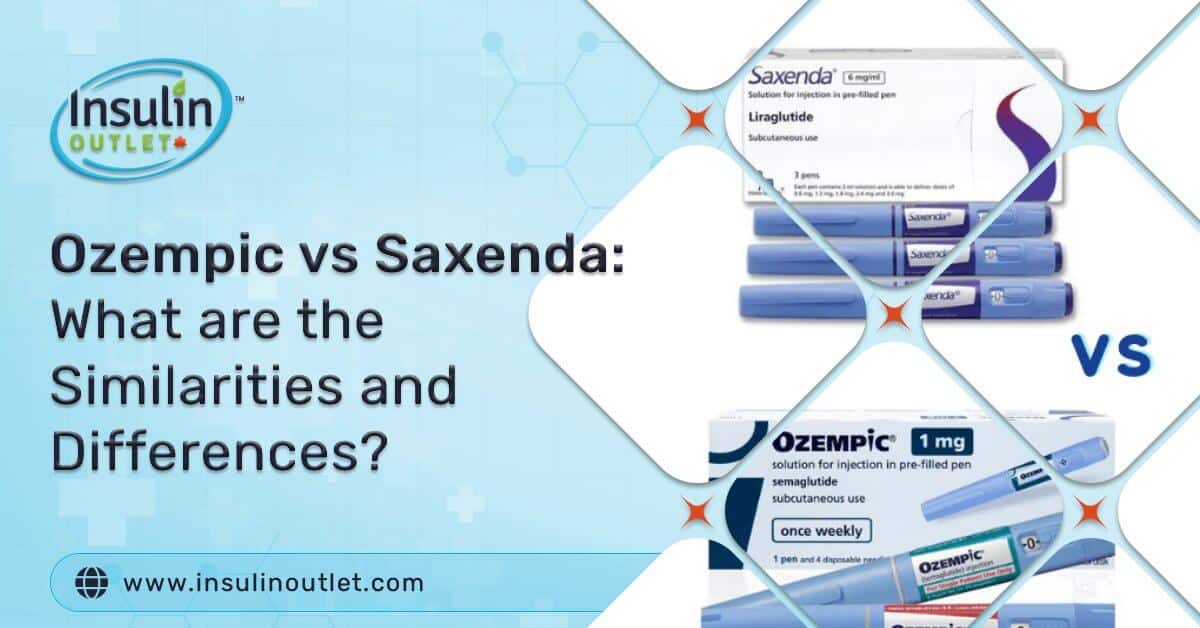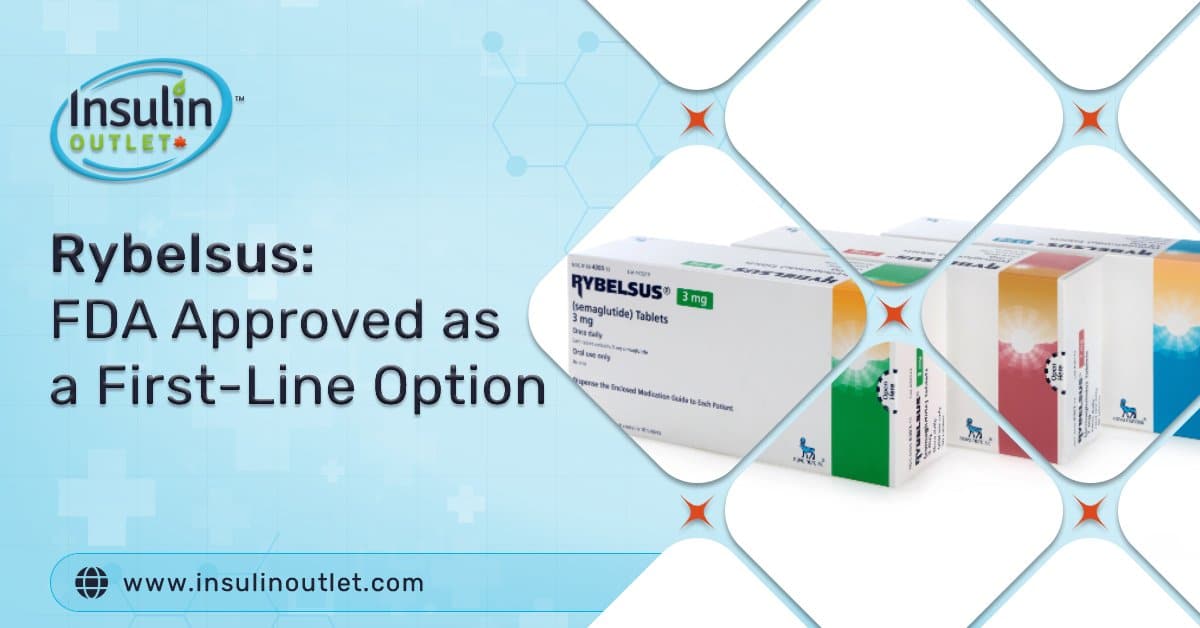
Today’s matchup is of the GL1 receptors: Ozempic vs. Saxenda! There has been a continuous increase in people with obesity and type 2 diabetes, despite countless governmental led interventions and diet plans in recent years. The increased awareness of eating healthy and prevalent information against the effects of obesity has not helped in lowering these numbers. Instead, it has radically increased the demand for medication to lower weight.
This has spiked research for drugs that effectively help people reduce weight. Some drugs on the market do this by increasing metabolism, while others suppress hunger by decreasing the absorption of glucose into your body, making you feel fuller for longer.
This research has led to a newer class of medications being introduced into the market called GLP1 receptor agonists. Saxenda and Ozempic are two of the many GLP1 receptor agonists.
Table Of Contents
ToggleWhat are GLP 1 Receptor Agonists?
GLP1 receptor agonists are a class of medication used to treat people with type 2 diabetes. They work in the body by targeting and stimulating GLP1 receptors in the pancreas. These receptors are linked with insulin and glucagon hormones, which stimulates them and increases the production of the former and decreases the production of the latter. This leads to many effects in the body, such as lowering blood sugar levels, making you feel full, and suppressing hunger.
GLP-1s have been shown to lower the risk of heart disease and kidney disease. They also control the body’s AC1 levels and are usually prescribed along with other medication and lifestyle changes to help treat patients with diabetes and cardiovascular complications.
Taken by themselves, GLP1s are beneficial for lowering hyperglycemia, but if taken with other medications that lower blood sugar levels, it can instead put a person at risk of hypoglycemia.
What is Ozempic?
Semaglutide, sold under the brand name Ozempic, is a medication used to treat patients with type 2 diabetes and used to reduce cardiovascular risk in patients with heart disease. Unlike traditional diabetes treatments, Ozempic is a non-insulin-based medication and is classified as a GLP1 receptor agonist as it imitates a naturally produced hormone in the body, GLP1.
Ozempic works in your body by helping the pancreas produce the right amount of insulin when blood sugar levels are elevated. The drug slows down the process of food being excreted from the body, which makes you feel satiated for longer and leads you to consume lesser calories. It is also recommended to be mindful of what you are eating and avoiding certain foods while taking Ozempic.
As Ozempic suppresses users’ hunger and makes them feel fuller for longer, patients with type 2 diabetes taking the medication often end up losing weight. Although it should be noted that the FDA has not approved it for weight loss
Pricing and Dosage for Ozempic
At the start of the treatment, 0.25mg of Ozempic may be given to patients weekly for the first four weeks for the body to get used to the treatment. The dosage is then increased to 0.5 mg once a week, which is equivalent to 1.5 mL per dose.
The average retail price of Ozempic (2mg/1.5mL) can cost approximately $1,042, but you can usually get it at the lowest price of $894 from a ordinary US pharmacy. However, at Insulin Outlet, you can buy Ozempic injectable pens at a fraction of the price for $469.79.
Saxenda Weight-Loss Pens
$514.99Possible Side Effects and Risks Associated with Taking Ozempic
As with any drug, Ozempic comes with its possible side effects that may occur while taking the medication. Listed below are common side effects that patients often report when treated with Ozempic. Although not all of them may occur, but if they do occur, they may need medical attention.
- Nausea
- Vomiting
- Diarrhea
- Abdominal pain
- Constipation
- Loss of appetite
- Darkened urine
- Blurred vision
Aside from unpleasant side effects, taking Ozempic also puts you at the risk of heartburn, stomach discomfort, anxiety, depression, headaches, vomiting, tightness in chest, unusual tiredness or weakness.
Ozempic is not recommended to treat pregnant women due to its long washout period and risk to the fetus. The medication is also not recommended for women breastfeeding as it has the potential to be excreted into the milk and possibly accumulate salcaprozate sodium in breastfed infants. If pregnancy is recognized, the medication should immediately be discontinued.
Drug and Disease Interactions Associated with Ozempic
Ozempic is known to interact with 245 drugs in total, with 2 of them being major interactions, 221 of them being moderate interactions, and 21 of them being minor interactions.
The drug also may affect the absorption of other medications that you take orally by either affecting how well or how fast those medications work.
Taking alcohol may also affect blood sugar levels in patients with diabetes and may interact with Ozempic. Consult your physician before consuming alcohol while on this medication
Ozempic can have a major interaction with certain mental and health conditions such as suicidal behavior and suicidal ideation and thyroid cancer.
Ozempic can also have a moderate interaction with certain health conditions such as: GI adverse events, hypoglycemia, pancreatitis and Retinopathy.
Since the drug has a high number of possible interactions, it is crucial to consult your physician before you start taking it.
Ozempic often gets compared to Trulicity. Although they have their similarities they differ in functionality and cannot replace one another without a doctors approval.
What is Saxenda?
Liraglutide, sold under the brand name Saxenda is a medication often prescribed to patients with obesity for weight loss. It is also prescribed to patients with type 2 diabetes as they often suffer from obesity. To see the most results with Saxenda, ensure you are eating the proper foods in your diet.
Saxenda imitates a hormone in the body called GLP1, which is produced by the lining of the intestines.
The drug is used in patients classified as either overweight or obese according to the BMI index.
Saxenda is sometimes interchanged with another drug for type 2 diabetes, Victoza, as they both have the same active ingredient. However, Saxenda and Victoza are not interchangeable as the former is approved for weight loss while the latter is not. Saxenda is also used in higher doses than Victoza.
Pricing and Dosage for Saxenda
At the start of the treatment, 0.6mg of Saxenda may be given to patients weekly for the first week for the body to get used to the treatment. The dosage is then increased by 0.6 mg per week for the next five weeks until the full maintenance dose of 3mg.
The cost of Saxenda subcutaneous solution (18mg/3mL) can cost approximately $1,430 for a supply of 15 mm. You can purchase Saxenda online from Canada for a fraction of the price through Insulin Outlet. We offer 5 pens of Saxenda for $514.99.
Possible Side Effects and Risks Associated with Taking Saxenda
As with any drug, Saxenda comes with its possible side effects that may occur while taking the medication. Listed below are common side effects that patients often report when treated with Saxenda. Although not all of them may occur, but if they do occur, they may need medical attention.
- Joint pain
- Loss of appetite
- Lower back or side pain
- Muscle aches and pains
- Bloody or cloudy urine
- Difficult, burning, or painful urination
- Bladder pain
- Trouble sleeping
Aside from unpleasant side effects, taking Saxenda also puts you at the risk of anxiety, depression, shakiness, increased hunger, hives or welts, itching, or skin rash, redness of the skin, slurred speech, loss of consciousness.
Saxenda is not recommended to treat pregnant women due to its long washout period and risk to the fetus. The medication is also not recommended for women breastfeeding as it has the potential to be excreted into the milk and possible weight loss in breastfed infants. If pregnancy is recognized, the medication should immediately be discontinued.
Drug and Disease Interactions Associated with Saxenda
Saxenda is known to interact with 249 drugs in total, with 2 of them being major interactions, 221 of them being moderate interactions, and 26 of them being minor interactions.
The drug may also affect the absorption of other medications you take orally by affecting how well or how fast those medications work.
consult your physician before using alcohol with Saxenda as alcohol consumption may affect blood sugar levels in patients with diabetes
Saxenda can have a major interaction with certain mental and health conditions, such as pancreatitis, thyroid carcinoma and depression.
Saxenda can have a moderate interaction with certain health conditions, such as renal dysfunction and cardiovascular disease.
Since the drug has a high number of possible interactions, it is crucial to consult your physician before you start taking it.
Ozempic vs. Saxenda
It is quite obvious that Ozempic and Saxenda have many similarities. However, they do serve different purposes and effectiveness would matter in accordance with the individual. Both medications are not attainable over-the-counter and require a prescription. Your doctor or healthcare advisor would be able to provide you with the proper medication for purchasing.
Ozempic vs. Saxenda; Similarities
Both Ozempic and Saxenda belong to the same class of drugs called glucagon-like peptide-1 (GLP-1) agonists. They work in the body by stimulating and increasing insulin levels and decreasing appetite.
Ozempic and Saxenda are both injected subcutaneously with a syringe and help control blood sugar levels and reduce weight.
Although Saxenda isn’t primarily given to patients with type 2 diabetes, unlike Ozempic, the patients who do receive Saxenda often also have type 2 diabetes.

Ozempic vs. Saxenda; Differences
Despite being the same class of drugs, Ozempic and Saxenda serve distinct functions in the body and have been approved by the FDA for different treatments.
Ozempic is primarily given to patients with type 2 diabetes or as a treatment to reduce cardiovascular risks. On the other hand, Saxenda is given to patients with obesity and weight-related issues.
Ozempic has a half-life of 168 hours and is usually administered once a week, whereas Saxenda has a half-life of 13 hours and must be given to patients daily.
Ozempic vs. Saxenda; Which One is Better?
It is frequently asked whether Ozempic is better or Saxenda. The answer only relies on what your needs are.
It all depends on what your healthcare professional has instructed you. They would know the finer details of your situation (age, sex, family history, current medications etc) and would be able to prescribe you with a medication that would suite you. Both medications require prescriptions for this reason. Do not take Ozempic or Saxenda without the guidance of a medical professional.
Whatever your doctor prescribes you would have to take. The cost of these medications can be rather high without insurance. That is why it is suggested to buy Ozempic and Saxenda through online prescription fillers like Insulin Outlet.
It is important to consult your doctor before taking either of these drugs. Talk to your medical professional and determine which one is best for you and whether you should take them.
Share:













